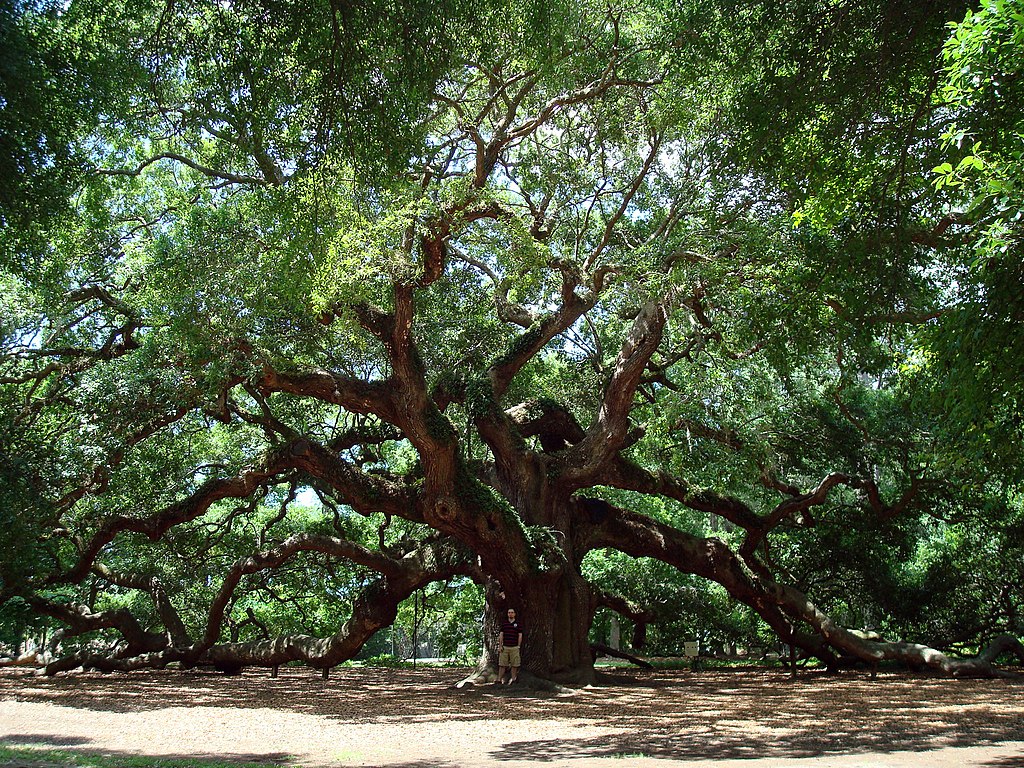
Photo: An enormous Southern Live Oak called “Angel Oak” in South Carolina. By DannyBoy7783 at English Wikipedia – Self-photographed, GFDL, https://commons.wikimedia.org/w/index.php?curid=81596614
By Caleb Clarkson
I fondly remember the trees that filled the yards and turfed alleys of my central Texas childhood neighborhood where I grew up. At the start of summer, when school finally got out, fragrant southern catalpas ceremoniously started the new season by drizzling cool dew and delicate white flowers across our yards, porches, and walkways.
In the dog days of summer, when the sun felt too oppressive for red-rover or freeze tag, we would play in the shade of our pecan tree, keeping a keen eye open for any early tree nuts ripe for snacking. People tend to favor the trees of home, and it has been no different for me; I was convinced that our trees must’ve been the tallest and widest in Texas!
I’m not the only one who has felt this way. Enthusiasm for special trees runs deep! Many organizations across Texas and America are dedicated to inventorying and protecting unique trees. Registries like the Texas Big Tree Registry measure a tree’s height, trunk circumference, and canopy crown to calculate its tree index, a number representing a tree’s overall size. Trees with the largest index for their species become state champions or even national champions!
Other groups like the Texas Historic Tree Coalition record the historical importance of trees, such as trees that acted as waypoints for native groups or pioneers, important historical meeting places, and much more. Brazoria County is home to many of these registered large and historic trees! For example, between Lake Jackson and Brazoria, near McFadden Bayou, lives the largest live oak (Quercus virginianus) in the state.
While big and old trees are historically important and amazing to view, they also play an important role in the environment. Bigger and older trees can perform more ecosystem services than their younger, smaller counterparts. Through photosynthesis, trees and other plants remove carbon dioxide (the most prominent greenhouse gas) from the atmosphere and convert it into oxygen, which is released, and solid carbon, which is stored within the plant’s cells.
When carbon is removed from the atmosphere by plants and the carbon cycle, it is considered “sequestered”. Older, larger trees have more biomass, allowing them to sequester and store more atmospheric carbon dioxide than younger, smaller trees. This trait allows forests with old trees to form the most densely packed carbon sinks on Earth.
Unfortunately, forests with old trees that haven’t been affected by logging and other human activities, or wildfires are dwindling. Those forests, called old-growth forests, are packed with full-grown trees of different ages ranging from 120 to 600 years or more. Old-growth forests that have reached their oldest ecological stage have incredibly biodiverse communities of plant and animal species whose populations stay relatively stable and persistent, perfect for a mature and lively forest!
Long ago, much of Brazoria County was covered in old, undisturbed forests that ran up and down the Brazos, San Bernard, and Colorado rivers and their respective floodplains. These frequently flooded forests form the Columbian Bottomlands, a bottomland forest that hosts a large diversity of plants, reptiles, amphibians, insects, birds, and mammals. The Columbian Bottomlands also provide a critical stopover habitat for millions of migrating birds who need food, shelter, and rest after crossing the Gulf of Mexico. Nowadays, only 215 acres of undisturbed Columbian Bottomlands exist, making it a critical habitat for protection.
While the days of vast, ancient Texas forests seem to be behind us, don’t lose heart! Appreciate those rare elderly trees as they work; catching sunlight and carbon. Sit in their shade and wonder who has sat there before, or listen for the tenants of the canopy, a bustling community of squirrels, birds, cicadas, and more that call the old tree their home. When you appreciate and protect a tree, you protect more than just an important cog in the environment. You protect the critters that live in and alongside that tree and its historical legacy and stories. And if you have a favorite tree that might not be old or big, protect it just the same, for every behemoth was once just a sapling.
